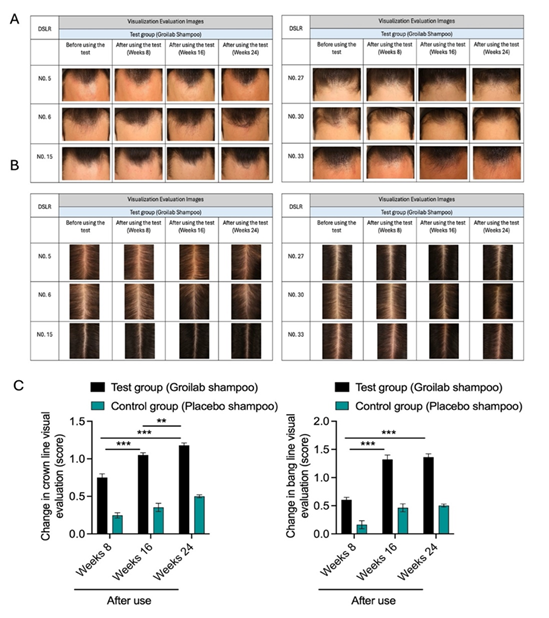Eficácia Clínica de Formulações de Plantas Medicinais para a Prevenção da Alopécia Androgenética em Indivíduos Coreanos
Conteúdo do artigo principal
Resumo
A alopecia androgenética (AGA) é a forma mais prevalente de alopecia não cicatricial, caracterizada por um padrão distinto de perda gradual de cabelo. Apesar de sua natureza não letal, a AGA pode exercer um impacto psicossocial significativo, especialmente em mulheres e homens mais jovens, afetando sua qualidade de vida. As abordagens terapêuticas padrão para a AGA geralmente envolvem o uso de finasterida e minoxidil; no entanto, esses tratamentos costumam estar associados a efeitos colaterais adversos, especialmente com o uso prolongado. Neste estudo, apresentamos o manejo bem-sucedido da AGA em uma coorte de indivíduos coreanos, composta por participantes do sexo masculino e feminino (totalizando 52 indivíduos, com 12 exclusões). Foram observadas reduções significativas na área afetada pela AGA em toda a coorte, resultando em desfechos altamente satisfatórios. Esses achados sugerem que a modalidade de tratamento empregada neste estudo oferece uma alternativa promissora para o manejo da AGA na população, demonstrando eficácia independentemente do gênero.
Detalhes do artigo

Este trabalho está licenciado sob uma licença Creative Commons Attribution 4.0 International License.
Authors retain the copyright of their articles and grant the journal the right of first publication under the Creative Commons Attribution (CC BY) license, which allows others to share and adapt the work with proper attribution.
Referências
Paik JH, Yoon JB, Sim WY, Kim BS, Kim NI. The prevalence and types of androgenetic alopecia in Korean men and women. Br J Dermatol. 2001;145(1):95-99. doi:10.1046/j.1365-2133.2001.04289.x.
Dawber RPR. Aetiology and pathophysiology of hair loss. Dermatology. 1987;175(Suppl 1):23-28. doi:10.1159/000248896.
Rinaldi F, Marzani B, Pinto D, Sorbellini E. Randomized controlled trial on a PRP-like cosmetic, biomimetic peptides based, for the treatment of alopecia areata. J Dermatolog Treat. 2019;30(6):588-593. doi:10.1080/09546634.2018.1544405.
Marahatta S, Agrawal S, Adhikari BR, Burkhart CG. Psychological impact of alopecia areata. Dermatol Res Pract. 2020;2020:8879343. doi:10.1155/2020/8879343.
Devkota HP, Paudel KR, Khanal S, Baral A, Panth N, Adhikari-Devkota A, Jha NK, Das N, Singh SK, Chellappan DK, Dua K, Hansbro PM. Stinging nettle (Urtica dioica L.): nutritional composition, bioactive compounds, and food functional properties. Molecules. 2022;27(16):521. doi:10.3390/molecules27165219.
Li Y, Sheng Y, Liu J, Xu G, Yu W, Cui Q, Lu X, Du P, An L. Hair-growth promoting effect and anti-inflammatory mechanism of Ginkgo biloba polysaccharides. Carbohydr Polym. 2022;278:118811. doi:10.1016/j.carbpol.2021.118811.
Zhang H, Shi Q, Nan W, Wang Y, Wang S, Yang F, Li G. Ginkgolide B and bilobalide promote the growth and increase β-catenin expression in hair follicle dermal papilla cells of American minks. Biofactors. 2019;45(6):950-958. doi:10.1002/biof.1562.
Roh SS, Kim CD, Lee MH, Hwang SL, Rang MJ, Yoon YK. The hair growth promoting effect of Sophora flavescens extract and its molecular regulation. J Dermatol Sci. 2002;30(1):43-49. doi:10.1016/s0923-1811(02)00060-9.
Takahashi T, Ishino A, Arai T, Hamada C, Nakazawa Y, Iwabuchi T, Tajima M. Improvement of androgenetic alopecia with topical Sophora flavescens Aiton extract, and identification of the two active compounds in the extract that stimulate proli-feration of human hair keratinocytes. Clin Exp Dermatol. 2016;41(3):302-307. doi:10.1111/ced.12753.
Im J, Hyun J, Kim SW, Bhang SH. Enhancing the angiogenic and proliferative capacity of dermal fibroblasts with mulberry (Morus alba L) root extract. Tissue Eng Regen Med. 2022;19(1):49-57. doi:10.1007/s13770-021-00404-6.
Hyun J, Im J, Kim SW, Kim HY, Seo I, Bhang SH. Morus alba root extract induces the anagen phase in the human hair follicle dermal papilla cells. Pharmaceutics. 2021;13(8):1155. doi:10.3390/pharmaceutics13081155.
Filaire E, Dreux A, Boutot C, Ranouille E, Berthon JY. Characteristics of healthy and androgenetic alopecia scalp microbiome: Effect of Lindera strychnifolia roots extract as a natural solution for its modulation. Int J Cosmet Sci. 2020;42(6):615-621. doi:10.1111/ics.12657.
Soe ZC, Ei ZZ, Visuttijai K, Chanvorachote P. Potential natural products regulation of molecular signaling pathway in dermal papilla stem cells. Molecules. 2023;28(14):5517. doi:10.3390/molecules28145517.
Hoffmann R. TrichoScan: a novel tool for the analysis of hair growth in vivo. J Invest Dermatol Symp Proc. 2003;8(1):109-115. doi:10.1046/j.1523-1747.2003.12183.x.
Hamilton JB. Patterned loss of hair in man: types and incidence. Ann N Y Acad Sci. 1951;53(3):708-728. doi:10.1111/j.1749-6632.1951.tb31971.x.
Birch MP, Lalla SC, Messenger AG. Female pattern hair loss. Clin Exp Dermatol. 2002;27(5):383-388. doi:10.1046/j.1365-2230.2002.01085.x.
Ludwig E. Classification of the types of androgenetic alopecia (common baldness) occurring in the female sex. Br J Dermatol. 1977;97(3):247-254. doi:10.1111/j.1365-2133.1977.tb15179.x.
Nestor MS, Ablon G, Gade A, Han H, Fischer DL. Treatment options for androgenetic alopecia: efficacy, side effects, com-pliance, financial considerations, and ethics. J Cosmet Dermatol. 2021;20(12):3759-3781. doi:10.1111/jocd.14537.
Park S, Kaushik N, Lee G, Sohn Y, Hong H, Shrestha KK, An RB, Park YK, Chang I, Kim JH. A platform for determining medicinal plants with targeted 17β-hydroxysteroid dehydrogenase modulation for possible hair loss prevention. Cosmetics. 2024;11(2):32. doi:10.3390/cosmetics11020032.
